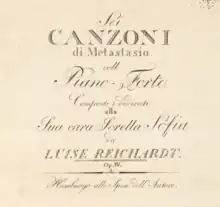Louise Reichardt
Louise Reichardt or Luise Reichardt (11 April 1779 – 17 November 1826) was a German composer and choral conductor. Her German songs, or Lieder, were written in an accessible style akin to folk music and were popular. Louise Reichard was known for composing in the style of “romantic songs,” which are based on poetic settings.[1] Additionally, she was influential in the musical life of Hamburg, Germany, where she lived from 1809.[2][3]

Biography
Early life
She was born in Berlin. She was the daughter of composers Juliane Reichardt (1752–1783) and Johann Friedrich Reichardt (1752–1814) and the granddaughter of Franz Benda (1709–1786). Her grandfather and father were, respectively, Konzertmeister and Kapellmeister at the court of Frederick the Great. After Juliane Reichardt died, the family moved from Berlin to Giebichenstein near Halle. Louise Reichardt took music lessons from her father, and in 1800 four of her songs were published in a collection of his songs.[2][3] The Reichardt family entertained literary figures such as Goethe, Ludwig Tieck, Novalis, Clemens Brentano, and Phillip Ludwig Achim von Arnim. Later, she would use von Arnim's poetry in a collection of twelve songs.[3]
Hamburg
In 1809 she moved to Hamburg, where she studied with Johann Frederich Clasing.[3] She taught music, instructed choruses, and composed. She did not rely on royalty or wealthy patrons to hear her music.[4] During her time in Hamburg, from 1809 until 1826, she composed the majority of her Lieder. She reached the public by writing in an easily accessible, folksy style,[3] combining memorable melodies with simple piano accompaniments.[4]
Reichardt was also active as a choral conductor and established a Gesangverein choral society in Hamburg. However, due to the prevailing sexism of the times, she was never allowed to conduct them in public.[3] "Despite these gender restrictions, Reichardt strongly influenced musical life in Hamburg through her composing, teaching, and behind-the-scenes conducting."[4] She also translated the Latin works of Hasse and Graun into German.[3]
Personal life
Reichardt’s husband-to-be, the writer Friedrich August Eschen, suddenly died before their wedding. Her second husband-to-be, the painter Franz Gareis, also died before their wedding.[4] From then on, Reichardt dedicated herself to her students in Hamburg, and toward the end of her life, she became intensely religious, composing two books of sacred songs.[5]
Works
Selected works include:
- Giusto Amor
- Notturno
- Vanne felice rio (Metastasio) (1806)
- Bergmannslied (Novalis)
- Heimweh (attributed to Wetzel)
- Die Blume der Blumen (Runge)
- Duettino (1802) (Brentano) (two tenors)
- From Des Knaben Wunderhorn: Hier liegt ein Spielmann begraben
- Betteley der Vögel
References
- PATSCH, HERMANN; STAUBER, BURKHARD (2019). ""Sehnsucht nach dem Tode" - "Longing for Death": Die Vertonung der 6. Hymne an die Nacht von Novalis durch den frühromantischen Komponisten Wilhelm Schneider". Archiv für Musikwissenschaft. 76 (1): 28–55. doi:10.25162/afmw-2019-0002. ISSN 0003-9292. JSTOR 26823161. S2CID 239128392.
- Sadie, Julie Anne; Samuel, Rhian (1994). The Norton/Grove dictionary of women composers. W. W. Norton & Company. ISBN 9780393034875. Retrieved 4 October 2010.
- Jezic, Diane; Wood, Elizabeth (1988). Women composers: the lost tradition found. Feminist Press at CUNY. ISBN 1-55861-073-1. Retrieved 27 October 2010.
- "Reichardt, Louise (1779–1826)". www.encyclopedia.com. Retrieved 15 December 2016.
- Jezic, Diane. Women Composers : The Lost Tradition Found / Diane Peacock Jezic ; Foreword by Elizabeth Wood. New York: Feminist Press at the City University of New York, 1988.